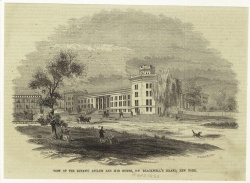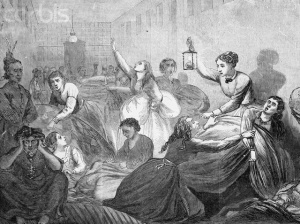Difference between revisions of "Manhattan Psychiatric Center"
| Line 33: | Line 33: | ||
==History== | ==History== | ||
| + | In 1871 when the new branch of the New York City Insane Asylum opened Ward's Island already was home to the Verplank State Emigrant Hospital, on the north eastern side, as well was the New York City Inebriate Asylum on the Southwestern part of the island, just below the new Insane Asylum. The new hospital building was built constructed of brick and Ohio free-state in the English Gothic Style with a Mansard roof. It was built in the Kirkbride style, with a three story central building with wings staggered back en echelon on either side. The cost of this structure was $700,000, and its overall frontage was 475 feet, with accommodation for 500 patients. | ||
| + | Upon opening the Ward's Island Asylum became the Male Department of the New York City Insane Asylum system, and it operated independently from the original Asylum, now the Female Department, on Blackwell's Island. Immediately all male patients were shipped up river to this new building. Regrettably this new hospital was no real improvement and suffered from many defects. The eating and lighting proved to be inadequate, the furniture was crude and many patients did not even have eating utensils to use at meal time. The nurse to patient ratio was one to 30 while the physicians proved inexperienced, only serving at the Asylum until they had enough experience to move on. Attendants proved similarly inadequate, as did treatment of patients, with many being locked in their rooms. The patients often were mingled with no regard to disease annd with no treatment. On top of this it was almost immediately the hospital found itself again overcrowded and looking for more space. | ||
| + | In 1875 the Wards Island Asylum transferred some patients to the former Inebriate Asylum, which had recently closed. However that same year the Ward's Island Homeopathic Hospital, which in 1894 would move to the Asylum buildings on Blackwell's island, took control of the building. In 1877 patients were sent to an unoccupied three story building, know as the "annex", formerly used by the Emigration Department to house immigrants. The building, having only open barracks style bays on each floor proved less than ideal for care of the insane. In 1880 some patients were transferred to the [[Hart Island Asylum]], a new branch which moved into Civil War era barracks formerly occupied by an industrial school. Their age and nature made them completely unsuitable for habitation by the mentally ill but they were forced to endure the conditions for several years. | ||
| − | + | Finally in 1878 Superintendent MacDonald requested a new wing to the original building, providing room for an additional 250 patients. For the sake of time and expedience a second ward on the other wing was also set to be built. Immediately patients and convicts from the work house set to work on the new additions to alleviate the overcrowding. Also under MacDonald there was a marked improvement in hospital management, food, and general welfare. He worked to not only ensure a better diet for the patients but also replaced the sub standard and uncomfortable furniture and increased the funding for patient amusement. By 1880 Dr. MacDonald succeeded in finally getting rid of the practice of using convicts in hospitals, arguing it brought an atmosphere of crime and depravity which held the hospitals progress back. In this year manual restraints were also abolished at the hospital. | |
| − | + | In 1879 four lectures on insanity were given at the hospital to the student physicians, with crowd ranging from 20 to over 200 at each. These were the first lectures of their kind given at a New York Insane Hospital. | |
| − | + | [[File:Blackwells Crowded Conditions.jpg|300px|left]] | |
| − | |||
| − | |||
| − | |||
| − | |||
| − | |||
| − | |||
| − | |||
| − | |||
| − | |||
| − | [[File: | ||
| − | |||
| − | |||
| − | |||
| − | |||
| Line 64: | Line 53: | ||
In 1890 the Federal Government took control of the Emigration Department, and when the new Emigration Station on Ellis Island opened in 1892 the former emigration complex and hospital on Ward's island was left under control of The New York City Asylum. In 1894 the 2000 patients from the Blackwell's Island Asylum were transferred to accommodation's on ward's island, bringing an end to the Asylum on Blackwell's Island. | In 1890 the Federal Government took control of the Emigration Department, and when the new Emigration Station on Ellis Island opened in 1892 the former emigration complex and hospital on Ward's island was left under control of The New York City Asylum. In 1894 the 2000 patients from the Blackwell's Island Asylum were transferred to accommodation's on ward's island, bringing an end to the Asylum on Blackwell's Island. | ||
| − | |||
| − | |||
| − | |||
== Images of Blackwell's Island Asylum == | == Images of Blackwell's Island Asylum == | ||
Revision as of 22:26, 28 September 2011
| Manhattan Psychiatric Center | |
|---|---|
 | |
| Established | 1868 |
| Construction Began | 1869 |
| Opened | 13 December 1871 |
| Current Status | Demolished (Kirkbride and original buildings) |
| Building Style | Kirkbride Plan |
| Architect(s) | Alexander Jackson Davis |
| Location | Wards's Island, NY |
| Architecture Style | English Gothic with Mansard roof |
| Alternate Names | New York City Insane Asylum Male Department, Ward's Island Asylum |
[[|300px|left]]
WORK IN PROGRESS 9/29/11
Background and Origins
Since 1839 the City of New York had been operating an asylum on Blackwell's Island for the care of the cities insane. At the time the vast majority of the insane under municipal care were poor immigrants, which at the time were pouring into New York City. As a result the population of the Blackwell's Island Asylum had steadily risen and was maintained in a perpetual state of overcrowding, providing only custodial care. To combat the rising population the asylum built a three story building for violent patients and later expanded to a three story building, formerly a workshop for the neighboring workhouse. Finally a series of one story pavilions were built however by 1868 the asylum only had accommodation for 640 of the 1035 patients under their care. The lack of room for expansion on Blackwell's Island, already hosting the city Asylum, Prison, Almshouses, and Workhouse, caused the city to look elsewhere. Nearby Ward's Island had been owned by the Department of Emmigration since 1847 and was already home to other city institutions. As a result a site was picked and the new branch of the asylum was established in 1868, opening to patient on December 12, 1871.
History
In 1871 when the new branch of the New York City Insane Asylum opened Ward's Island already was home to the Verplank State Emigrant Hospital, on the north eastern side, as well was the New York City Inebriate Asylum on the Southwestern part of the island, just below the new Insane Asylum. The new hospital building was built constructed of brick and Ohio free-state in the English Gothic Style with a Mansard roof. It was built in the Kirkbride style, with a three story central building with wings staggered back en echelon on either side. The cost of this structure was $700,000, and its overall frontage was 475 feet, with accommodation for 500 patients.
Upon opening the Ward's Island Asylum became the Male Department of the New York City Insane Asylum system, and it operated independently from the original Asylum, now the Female Department, on Blackwell's Island. Immediately all male patients were shipped up river to this new building. Regrettably this new hospital was no real improvement and suffered from many defects. The eating and lighting proved to be inadequate, the furniture was crude and many patients did not even have eating utensils to use at meal time. The nurse to patient ratio was one to 30 while the physicians proved inexperienced, only serving at the Asylum until they had enough experience to move on. Attendants proved similarly inadequate, as did treatment of patients, with many being locked in their rooms. The patients often were mingled with no regard to disease annd with no treatment. On top of this it was almost immediately the hospital found itself again overcrowded and looking for more space.
In 1875 the Wards Island Asylum transferred some patients to the former Inebriate Asylum, which had recently closed. However that same year the Ward's Island Homeopathic Hospital, which in 1894 would move to the Asylum buildings on Blackwell's island, took control of the building. In 1877 patients were sent to an unoccupied three story building, know as the "annex", formerly used by the Emigration Department to house immigrants. The building, having only open barracks style bays on each floor proved less than ideal for care of the insane. In 1880 some patients were transferred to the Hart Island Asylum, a new branch which moved into Civil War era barracks formerly occupied by an industrial school. Their age and nature made them completely unsuitable for habitation by the mentally ill but they were forced to endure the conditions for several years.
Finally in 1878 Superintendent MacDonald requested a new wing to the original building, providing room for an additional 250 patients. For the sake of time and expedience a second ward on the other wing was also set to be built. Immediately patients and convicts from the work house set to work on the new additions to alleviate the overcrowding. Also under MacDonald there was a marked improvement in hospital management, food, and general welfare. He worked to not only ensure a better diet for the patients but also replaced the sub standard and uncomfortable furniture and increased the funding for patient amusement. By 1880 Dr. MacDonald succeeded in finally getting rid of the practice of using convicts in hospitals, arguing it brought an atmosphere of crime and depravity which held the hospitals progress back. In this year manual restraints were also abolished at the hospital.
In 1879 four lectures on insanity were given at the hospital to the student physicians, with crowd ranging from 20 to over 200 at each. These were the first lectures of their kind given at a New York Insane Hospital.
Closing
When the hospital on Ward's Island was completed on December 12, 1871 with accommodations for 500 all male patients from Blackwell's Island were transferred there. Despite this transfer of 400 patients the overcrowding at Blackwell's was so extreme 400 patients still slept on the floor nightly. In 1880 a new branch of the hospital was opened on old buildings on Hart Island and by 1886 new buildings had been begun at Central Islip, on Long Island. By 1892 the New York City Hospital consisted of four departments, The original on Blackwell's Island, a large complex on Ward's Island, Hart's Island, and the new facilities at Central Islip, with a total patient population of 7478 patients.
In 1890 the Federal Government took control of the Emigration Department, and when the new Emigration Station on Ellis Island opened in 1892 the former emigration complex and hospital on Ward's island was left under control of The New York City Asylum. In 1894 the 2000 patients from the Blackwell's Island Asylum were transferred to accommodation's on ward's island, bringing an end to the Asylum on Blackwell's Island.
Images of Blackwell's Island Asylum
Main Image Gallery: Blackwell's Island Asylum
Links
The institutional care of the insane in the United States and Canada, Volume 3
